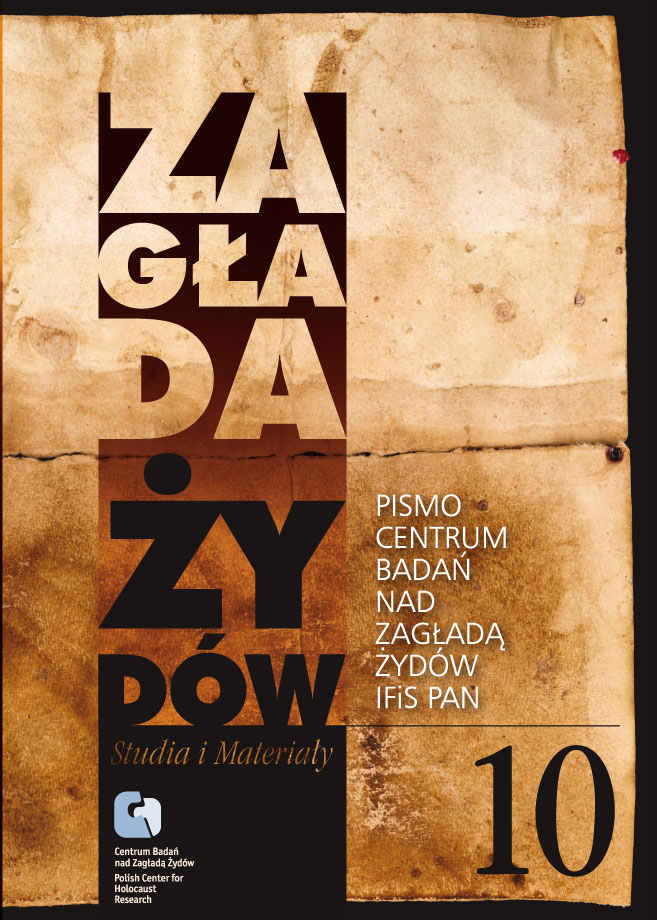Krzesiny i Kreising – między pamiętaniem a pomijaniem. Polskie miasteczko wobec historii, pamięci i rywalizacji w cierpieniu
Zagłada Żydów. Studia i Materiały, Nr 10 (2014), Strony: 443-461
Data zgłoszenia: 2020-10-22Data publikacji: 2014-12-01
 https://doi.org/10.32927/ZZSiM.532
https://doi.org/10.32927/ZZSiM.532
Abstrakt
The area around Krzesiny, located near the city of Poznań, Poland, witnessed several dark events during World War II: Germans oppressed the local population, culminating in a terrorizing action dubbed “akcja krzesińska;” also, a forced labor camp, named “Kreising,” was built near the township, housing mainly Jews. After the war, the suffering in Krzesiny was remembered, but selectively – “akcja” and other forms of Polish suffering were commemorated, while the camp was not. By exploring the “lieux de mémoire” in Krzesiny – dynamics of memory in a small township in Poland – this paper uses localized research to address the issue of gaps in collective memory and commemoration. We briefly look at the relevant history, Polish memory regarding wartime events in Krzesiny, and the postwar dynamics of collective memory. Discussing the latter, we identify a new phenomenon at work, one which we dub “collective disregard” – group neglect of the past of the “Other” that occurs without clear intent. We argue that “collective disregard” is an issue that naturally occurs in the dynamics of memory. By making a deliberate investment in balanced remembrance and commemoration, societies can counter the tendencies of “disregard” and curb the controversies of competitive victimization claims, also called “competitive martyrdom”.
Licencja
Prawa autorskie (c) 2014 Autor&"Zagłada Żydów. Studia i Materiały"

Utwór dostępny jest na licencji Creative Commons Uznanie autorstwa 4.0 Międzynarodowe.
https://creativecommons.org/licenses/by/4.0
Czasopismo publikowane jest w standardzie Diamond Open Access na licencji CC-BY-4.0 Deed - Uznanie autorstwa 4.0 Międzynarodowa - Creative Commons
Podobne artykuły
- Zofia Wóycicka, Sarah Gunsburger, National Policy, Global Memory: The Commemoration of the „Righteous” from Jerusalem to Paris, 1942–2007 , Zagłada Żydów. Studia i Materiały: Nr 13 (2017)
- Tadeusz Epsztein, Wspomnienie o dr Rucie Sakowskiej (1922–2011) , Zagłada Żydów. Studia i Materiały: Nr 10 (2014)
- Ewa Cuber-Strutyńska, Witold Pilecki. Confronting the legend of the “volunteer to Auschwitz” , Zagłada Żydów. Studia i Materiały: Nr Holocaust Studies and Materials (2017)
- Michał Kowalski, Na polach Treblinki. Profanacja terenów po obozie śmierci w świetle relacji i dokumentów , Zagłada Żydów. Studia i Materiały: Nr 17 (2021)
- Justyna Kowalska-Leder, „Zawołani po imieniu”, czyli Krzywda i Sprawiedliwość , Zagłada Żydów. Studia i Materiały: Nr 18 (2022)
- Dariusz Libionka, Polskie piśmiennictwo na temat zorganizowanej i indywidualnej pomocy Żydom (1945–2008) , Zagłada Żydów. Studia i Materiały: Nr 4 (2008)
- Agnieszka Haska, Piotr Forecki, Po Jedwabnem. Anatomia pamięci funkcjonalnej, Warszawa: Wydawnictwo IBL PAN, 2018, 434 s , Zagłada Żydów. Studia i Materiały: Nr 15 (2019)
- Marta Kubiszyn, Joanna Zętar, Miasto po Zagładzie. Dzielnica żydowska w Lublinie i jej upamiętnienia , Zagłada Żydów. Studia i Materiały: Nr 14 (2018)
- Marta Janczewska, Research on Starvation in the Warsaw Ghetto – Ethical Problems , Zagłada Żydów. Studia i Materiały: 2010: Holocaust Studies and Materials
- Ewa Koźmińska-Frejlak, Świadectwo milczenia…Rozmowa z Jerzym Lewińskim, byłym funkcjonariuszem Służby Porządkowej getta warszawskiego , Zagłada Żydów. Studia i Materiały: Nr 2 (2006)
<< < 6 7 8 9 10 11 12 13 14 15 16 17 18 19 20 21 22 23 24 25 26 27 28 29 30 31 32 33 34 > >>
Możesz również Rozpocznij zaawansowane wyszukiwanie podobieństw dla tego artykułu.
 English
English
 Język Polski
Język Polski




